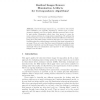Free Online Productivity Tools
i2Speak
i2Symbol
i2OCR
iTex2Img
iWeb2Print
iWeb2Shot
i2Type
iPdf2Split
iPdf2Merge
i2Bopomofo
i2Arabic
i2Style
i2Image
i2PDF
iLatex2Rtf
Sci2ools
DAGM
2009
Springer
2009
Springer
Residual Images Remove Illumination Artifacts!
Real-world image sequences (e.g., recorded for vision-based driver assistance) are typically degraded by various types of noise, changes in lighting, out-of-focus lenses, differing exposures, and so forth. In past studies, illumination effects have been proven to cause the most common problems in correspondence algorithms. We address this problem using the concept of residuals, which is the difference between an image and a smoothed version of itself. In this paper, we conduct a study identifying that the residual images contain the important information in an image. We go on to show that they remove illumination artifacts using a mixture of synthetic and real-life images. This effect is highlighted more drastically when the illumination and exposure of the corresponding images is not the same.
DAGM 2009 | Image Processing | Images | Real-world Image Sequences | Vision-based Driver Assistance |
| Added | 26 May 2010 |
| Updated | 26 May 2010 |
| Type | Conference |
| Year | 2009 |
| Where | DAGM |
| Authors | Tobi Vaudrey, Reinhard Klette |
Comments (0)

